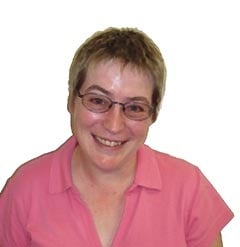The fixer : Stone on anhydrite screed
Amanda Searle, Head of Technical Services at Norcros Adhesives, offers advice on fixing decorative stone finishes. In this issue she discusses fixing natural stone in association with anhydrite screed
Anhydrite, Gypsum, Calcium Sulphate, Alpha Hemihydrite, Gyvlon. These are screeds based on a binder of calcium sulphate that are self levelling (self smoothing). They have become popular as a substrate for floors due to the benefits they offer: they can be pump applied, making them as much as 10 times faster to put down than conventional sand:cement screeds; they have minimal shrinkage, cracking and curling; their rapid strength development permits foot trafficking just 24 to 48 hours after they are in.
They are also suitable for use with underfloor heating systems.
It should be noted, however, that due to the composition of these screeds, they are considered to be unsuitable for use in areas which may be subjected to dampness and wetting, and that the drying rate is dependent on the screed thickness as well as site conditions.
To ensure a successful tiled installation it is essential that the screed has a low moisture content and is correctly prepared before tile fixing commences.
The screed must be allowed to dry out according to the manufacturers recommendations. This is generally at a rate of one day per millimetre of screed thickness for screeds up to 40mm thick, and two days per millimetre for any additional thickness over 40mm. A final moisture content of no greater than 0.5%w/w or 75% Relative Humidity (RH) is required.
Before the tiles are laid it is essential that surface laitance is removed by light sanding. This is generally carried out four to six days after the screed has been applied and will provide a dense surface to receive adhesives as well as assisting drying.
The screed must be primed / sealed to prevent the formation of ettringite, an expansile crystal created by a chemical reaction between the sulphates in the screed and a cement-based adhesive. When using a primer (Styrene Butadiene Rubber or SBR) such as Norcros Prime Bond the screed should be primed using progressively stronger coats.
An initial coat diluted 1:4 parts water and allowed to dry should be followed by a second coat at a 1:3 dilution applied at right angles to the first coat and allowed to dry. If the surface of the screed is still absorbent, a third coat at a dilution of 1:2 will be required.
Once the screed is dry and has been primed, and the primer is dry, the tiles can be fixed in the usual way, ensuring that a suitable adhesive is used.
Where underfloor heating has been installed it is essential that a flexible C2 cement-based adhesive such as Norcros Thick Bed Stone & Porcelain Adhesive is used. A C1 adhesive should only be used on unheated floors.
The Tile Association (TTA) document Tiling to Calcium Sulfate based Screeds recommends that movement joints should be incorporated as follows:
Unheated Anhydrite Screeds
- Over structural joints in the underlying construction, at day joints in floating or unbonded screeds that are likely to be subject to movement.
- At floor perimeters where the screed abuts walls and upstands at doorway thresholds.
- At junctions between heated and unheated sections of the screed
- As a boundary joint, generally with a side length 20m or in accordance with the screed manufacturer’s instructions.
Heated Anhydrite Screeds
- Over structural joints in the underlying construction, at day joints in floating or unbonded screeds that are likely to be subject to movement.
- At floor perimeters where the screed abuts walls and upstands at doorway thresholds.
- Through both the screed and tile bed dividing the tiling into bays not greater than 40m2 or in accordance with the screed manufacturer’s recommendations. The bays should be square or rectangular with the width to length ratio not exceeding 5 to 8.
- At significant changes of width of the screed surface and in doorways (ground plan length over 5m) with several rooms arranged one after another within a floor plan.
- As a boundary joint isolating areas of screed with separately controlled heating circuits.
- At doorways between separate areas of use.
- At junctions between heated and unheated sections of the screed.
Amanda Searle, head of Technical Services at Norcros Adhesives. For more information contact the Technical Helpline on Tel: 0870 609 2851 or Email: technical@norcros-adhesives.com

